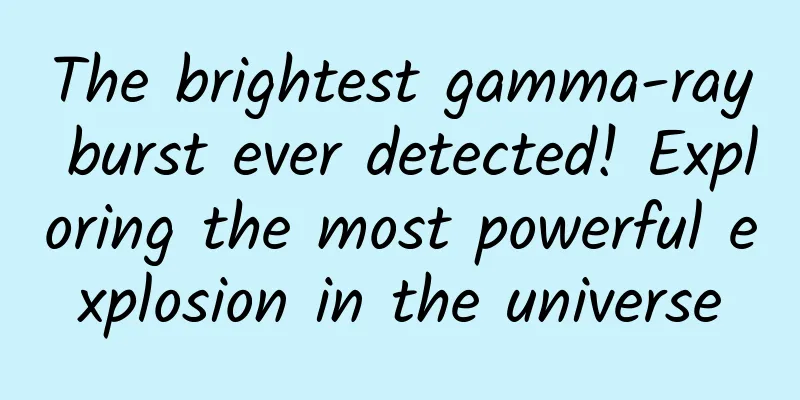The brightest gamma-ray burst ever detected! Exploring the most powerful explosion in the universe

|
Recently, my country's Insight-HXMT satellite and Polaris space telescope accurately detected the brightest gamma-ray burst to date, which attracted much attention. So what exactly is a gamma-ray burst? How powerful is this burst? Schematic diagram of a gamma-ray burst Back in the 1960s, the United States launched the Vela Project, launching 12 satellites equipped with X-ray detectors, gamma-ray detectors, neutron detectors and other equipment to detect nuclear explosions near the Earth and in the atmosphere. These satellites were launched between 1963 and 1970. In July 1967, the satellites discovered for the first time that the signal in the gamma-ray band suddenly increased and then quickly decreased, with no regularity in time, but the intensity was even greater than the total gamma-rays of the entire day. More importantly, this phenomenon does not come from the surface of the earth, but from the universe, known as a gamma-ray burst. Since then, the Vela Project has observed similar phenomena many times in succession, but because gamma-ray bursts last for a short time and their direction is difficult to determine, research progress was very slow at first. In April 1991, the Compton Gamma-ray Observatory, a professional satellite in this field, was launched. In the following nine years, it discovered more than 2,700 gamma-ray bursts, and they were evenly distributed in the sky, not concentrated in the Milky Way. This means that the origin of gamma-ray bursts is outside the Milky Way, proving once again that it has incredible energy, so it can be observed by us from afar. So how much energy does a gamma-ray burst release? The gamma-ray burst GRB 990123 recorded in January 1999 lasted for more than a minute. The ROTSE-1 optical telescope in the United States found that its optical counterpart rapidly brightened from magnitude 18 to magnitude 9, an increase of about 4,000 times, 22 seconds later. It was then calculated based on spectral analysis that it is about 9 billion light-years away from us. Comprehensive calculations show that the energy released by this gamma-ray burst exceeds the total radiation energy of all stars in the Milky Way from the year 1 to the present! Subsequent studies have shown that the duration of gamma-ray bursts generally ranges from 0.01 seconds to 1000 seconds, and they are divided into long bursts and short bursts with 2 seconds as the boundary. Long bursts account for 70% of the total number of discoveries, and are often accompanied by bright afterglows. Their counterparts can be found in the visible light, X-ray and other bands. Astronomers believe that long bursts are often associated with the "death" of massive stars and originate from the process of massive stars collapsing into black holes. Short bursts are relatively rare. In the past 20 years, astronomers have only located dozens of short burst counterparts, and believe that they originate from the merger of two compact celestial bodies (such as neutron stars or black holes). In October 2022, the strongest gamma-ray burst ever recorded, GRB 221009A, lasted for more than 300 seconds, blinding many detectors and making it impossible for astronomers to directly record its true intensity. Observations from many telescopes showed that this gamma-ray burst was "the most violent ever recorded in human civilization" and was 70 times brighter than the previously recorded burst. my country's Insight-HXMT satellite has made the highest international precision measurements of the instantaneous radiation and early afterglow of the gamma-ray burst in the hard X-ray and soft gamma energy bands. How much of an impact do gamma-ray bursts have on us? Fortunately, all gamma-ray bursts observed so far have come from outside the Milky Way and have little impact on Earth. If a gamma-ray burst occurred within the Milky Way, it would be expected to cause devastating damage to Earth's ecosystem. Although the Earth's atmosphere can effectively absorb X-rays and gamma rays, gamma-ray bursts are enough to cause oxygen-nitrogen chemical reactions in the atmosphere. The increased nitrogen oxides will consume a large amount of ozone, leading to increased ultraviolet radiation on the surface, diffuse photochemical smog, and thus weakening plant photosynthesis, and aggravating acid rain... In short, gamma-ray bursts thousands of light years away will gradually destroy the Earth's ecosystem within a few years after the outbreak. Some studies believe that the Ordovician-Silurian mass extinction 450 million years ago was likely caused by a gamma-ray burst. (Author: Ye Nan) |
<<: A magical journey of a "blood train"
>>: What! We won't be able to drink Coke in half a year?
Recommend
How did the 3D printed cake come about and what does it taste like?
Cake is an ancient Western pastry, usually made i...
Wearing masks is no longer mandatory! These places have made it clear →
On March 13, the Ministry of Education, the Natio...
He turned a Ferrari into an electric car
Standing next to a Ferrari, you can hear the deaf...
How to find deleted WeChat payment records? Official tips
Nowadays, mobile payment has become the norm when...
How much does it cost to be an agent for a catering mini app in Liuzhou?
Is it easy to be an agent of Liuzhou catering min...
Xiao Ming's short video traffic generation and monetization course is a must-have, super monetization rules, and the live broadcast room has gained 200,000+ fans in two days
Xiao Ming's short video traffic monetization ...
Luckin Coffee’s stock price has been falling due to short selling! Why is it so difficult to make coffee?
On January 31, Muddy Waters Research, a well-know...
Online Marketing Promotion: How to Spend the Big Money? Fine-tuned operation of large traffic!
0 cost, small budget, replicable, attracting hund...
Overview of the public platform message body signature and encryption and decryption solution
Overview of the public platform message body sign...
Short video live streaming skills
This time I will share with you some live broadca...
When will household solar power generation say goodbye to “polarization”?
Recently, there have been frequent news reports o...
Short video operation and script writing!
In an era where content is king, the account posi...
Virtual reality technology has been initially applied in enterprises
[[125122]] Virtual reality-based prototyping and ...









